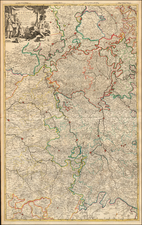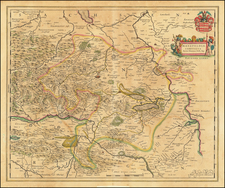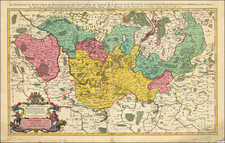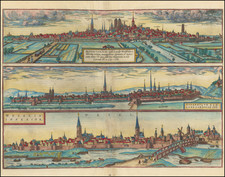Scarce birdseye view of Coblentz, at the confluence of the Rhine River and the Mosell River, with a key locating 19 churches and other buildings and two columns of text (Latin and German).
Landmarks shown include:
From the list provided, the most famous six places in Coblentz (modern-day Koblenz, Germany) during the early 18th Century, along with a brief history, are:
-
Caftellu Ehrenbrettftein, vulgo Hermanftein (Ehrenbreitstein Fortress):
This is undoubtedly one of the most iconic landmarks in Koblenz. Located atop a hill on the right bank of the Rhine, Ehrenbreitstein Fortress dates back to the early 11th century. It played a crucial role in the defense of the region throughout its history. In the early 18th century, its strategic importance was well-recognized, and it was a symbol of the Electoral-Trier state's might. -
Domus Equitu Teuton (Teutonic Knights' House):
The Teutonic Order, a Catholic religious order founded in the 12th century, had a significant presence in various parts of Europe, including Koblenz. Their house in the city would have served as a base for their religious and charitable activities. -
Porta ad Rhenu (Rhine Gate):
As an entrance to the city from the Rhine side, this gate would have been significant for trade and defense. City gates often hold historical importance, reflecting the architectural style of their time and serving as critical checkpoints. -
Colleg. ad S.Caftor (St. Castor's College):
St. Castor's is the oldest church in Koblenz, dating back to the 9th century. By the 18th century, it would have been an established religious and educational center, with the attached college contributing to the intellectual life of the city. -
PP.Jesuit.Templ (Jesuit Church and College):
The Jesuit order had a significant influence in many parts of Europe, especially in education. Their presence in Koblenz would have been central to religious, educational, and cultural activities, making their church and college notable landmarks. -
Carthusia (Carthusian Monastery):
The Carthusian Order, known for its strict adherence to monastic solitude and contemplation, had establishments across Europe. Their monastery in Koblenz would have been a center of spiritual life and a testament to the city's religious diversity in the 18th century.
Originally drawn by Werner and published by Engelbrecht in Augsburg. In the foreground, there is a large figural vignette depicting a fleur d'lis, grapes and and snakes, along with images of fish.












![[ Jülich Kleve ] De Hertochdommen Gulick Cleve Berghe en de Graeffchappen vander Marck en Ravensbergh . . . 1610](https://storage.googleapis.com/raremaps/img/small/99226.jpg)

![(Central Europe) Novissima Marchionatus Misniae Maximaeque Partis Voitlandiae Tabula [Newest map of the Margraviate of Meissen and the largest part of Voigtland]](https://storage.googleapis.com/raremaps/img/small/91160.jpg)